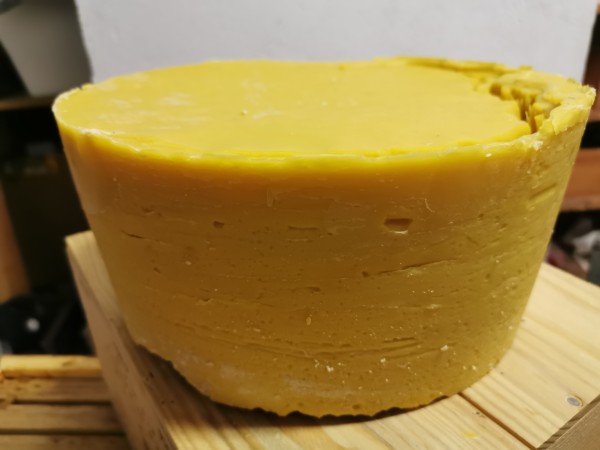In addition to honey, there are numerous other natural substances that bees give us. One of the most interesting is beeswax, a collection of about 300 individual substances, mainly esters and hydrocarbons, which is easily moldable at room temperature and has antibacterial properties.
How beeswax is produced
In order to produce honeycombs in the beehive, in which the brood is raised up to the full-fledged bee, the building bees have 8 small wax glands on the rear abdomen at the age of 12-18 days, from which the wax is sweated out as required and formed into fine leaves in the intermediate ring pockets. These fine wax leaves are chewed, shaped and joined together by the bee. During this process, the bee also gives the wax its antibacterial, skin-friendly properties, which it gets from several other glands in its body.
Wax extraction is a complex process for the bees. A bee can only produce and process 8 wax leaves per day, requiring about four times the amount of honey. The beeswax is incredibly light, 1 g beeswax is made from 1250 wax leaves, which means that many bees are needed in spring to build enough honeycombs in the colony for the offspring.
Architecturally, honeycombs are a wonder of nature. With a minimum use of material, highly stable connections with optimal volume are created in order to take in complete bees from bee eggs and food juice. Beeswax is reusable, because the bee can soften the wax in one part of the bee structure with the secretion of its mandibular glands and then reinstall it in a honeycomb in another part. In doing so, it controls the shape of the cell and thickness of the honeycomb wall with the sensory organs of its antennae.
Extraction and use of beeswax
The beekeeper extracts the wax during the honey harvest when the honeycombs are uncovered and after the honey season, when old combs are to be replaced by new combs after 2-3 years in the hive. The old combs then carry the remnants of continuous breeding - excrement, nymph skins from the moulting process, treatment remnants from varroa therapy and others. Honeycomb uncovering wax and old combs are each melted down and filtered several times to obtain a pure natural wax at the end. From the uncovering wax, new middle walls for brood and honeycombs are created, which are soldered into frames and which the bees develop into new honeycombs.
From the other wax a variety of products can be created. Beeswax is widely used in the cosmetic and pharmaceutical industries due to its skin-friendly and antibacterial properties. As a candle, it gives light and warmth in an environmentally friendly way and has an unmistakable scent.
Beeswax wraps
We use our beeswax to create a sustainable alternative to plastic film used for food storage. For hygienic reasons, this is usually only used once and then becomes waste. This creates gigantic amounts of plastic waste, which in the worst case scenario ends up in our food as microplastics. In order to prevent this, we cut cloths of various sizes out of unused cotton wraps of fabric and soak them in hot wax. In this way we give them a very high stable formability to enclose and thus protect vessels or food. At the same time, the antibacterial properties of the wax prevent bad germs from colonising the food. Thus we use a permanent food-safe packaging possibility.
If you also want to pack and store your food in an environmentally friendly way with durable materials, you will find a variety of beeswax tissues in different shapes and sizes for your refrigerator in our shop.



